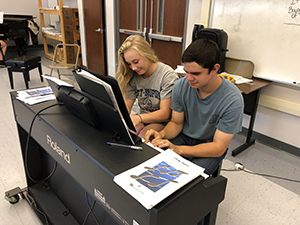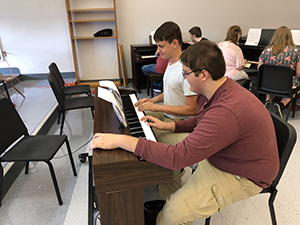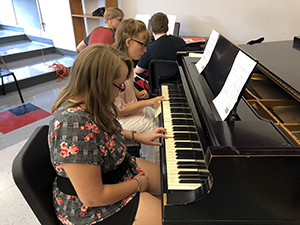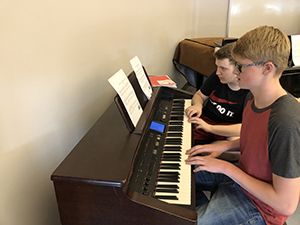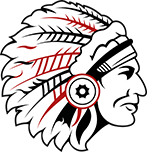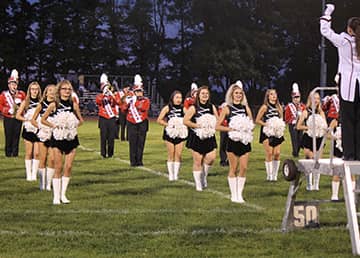
Fine Arts
The arts surround us—the music we listen to, the pictures we see, a store logo, a website design, and even the food we eat. The arts offer us opportunities to not only express our own creativity but to evoke emotion in others. We believe in the beauty and necessity of including the arts in education and offer a wide range of fine arts courses for our students to participate in.
Art History (Grades 9–12)
Art History students study various art movements from different cultures and time periods. After learning about an art movement, students create a piece of art reflective of that particular art movement or time period. For example, following the Greek art movement, students may make a ceramic Greek-inspired vase.
.5 Credit
Band (Grades 9–12)
Senior high students who play an instrument have the opportunity to perform in an ensemble setting at all football games, several parades, and four public concerts throughout the school year. We require band students to participate at all performances.
1 Credit
Ceramics (Grades Vary by Level)
Ceramics 1 (Grades 9–12)
Ceramics 1 introduces students to the various ceramic handbuilding processes and helps them to develop a working knowledge of wheel-thrown pottery. The course integrates the design and construction of ceramic ware using a full spectrum of artistic tools, techniques, and materials. The students learn surface decoration and glazing methods and about multiple types of kilns and firing processes. Additionally, we cover the history of ceramics, work of contemporary artists, and various ceramic careers.
.5 Credit
Ceramics 2 (Grades 10–12)
Students build upon skills from the Ceramics 1 course, reviewing handbuilding techniques (slab, coil, cut and scoop, pinch pot). During this course, students begin working with the potter’s wheel, a primary focus in this course. Students learn how to load and unload a kiln, the history of ceramics, and historical and contemporary ceramic work, art careers, and kiln types.
.5 Credit
Prerequisites: Studio 1, Ceramics 1
Chef's Corner/Creative Cooking (Grades 11–12)
This course provides advanced instruction in basic food preparation and nutritional information with labs focused on basic foods and cooking techniques. Students explore foods from various regions around the world by reviewing distinct dishes and the different factors that influence the types of food the people eat. Food units concentrate on the preparation of meats and casseroles and teach students how to combine individual foods in many imaginative ways to create new and interesting dishes. Students learn that certain combinations of foods can take a variety of forms while including many combinations of ingredients.
.5 Credit
Prerequisite: 75% in Family Consumer Science 1
Choir (Grades 9–12)
Concert Choir
The Concert Choir is a mixed choral group that meets daily to rehearse a variety of musical styles. We incorporate singing skills, music theory, and music reading. We require students to participate in all concerts.
1 Credit
Ensemble Choir
Students selected for this competitive mixed choral group meet daily to rehearse performance-based programming. Ensemble choir incorporates various styles of music along with a variety of skills related to music reading and interpretation. We require ensemble members to participate in all scheduled concerts and performances.
1 Credit
College & Career Portfolio (Grades 10–12)
Students plan for their future by conducting a self-analysis including personality, interest, and value assessments. Students create and maintain a personal portfolio utilizing 21st-century skills. The final project (the online portfolio) showcases what each student has discovered during the course, including their short- and long-term goals, development of the necessary tools to obtain employment, college research, and preparation for the college application process.
.5 Credit
Dance & Drill Squad (Grades 9–12)
During football season, Dance & Drill Squad members participate in band activities and performance. After football season, Dance & Drill Squad members may opt to continue in either the band or choir (1 credit) or take study hall for the remainder of the first semester (no credit). We require students to audition and compete for a position on the Dance & Drill Squad. Squad members who choose not to participate in the band or choir may select an elective for the second semester.
Up to 1 Credit
Drawing (Grades 10–12)
This courses focuses on various drawing techniques, tools, and media. The curriculum includes an in-depth study of value, texture, gesture, still life, and drawing from life. Students receive an introduction to historical and contemporary working artists.
.5 Credit
Family & Consumer Sciences (Grades Vary Based on Level)
Family & Consumer Science 2: Basic Baking (Grades 9–12)
This course provides an overview of baking and allows students to learn basic techniques for making quick breads, cakes, cookies, candies, pies, and tarts. The course emphasizes the baking process, leavening agents, and the importance of careful measuring and precisely following directions.
.5 Credit
Prerequisite: 75% in Family & Consumer Science 1
Family & Consumer Science 3 (Grades 10–12)
In this comprehensive course, students demonstrate skills in all areas of family and consumer sciences education. Students receive instruction in areas critical to the success of balancing family and employment responsibilities and includes instruction in the areas of family life, nutrition and food, textiles and clothing, housing and interiors, child development, childcare, and consumer education.
1 Credit
Prerequisite: 75% in Family & Consumer Science 2
Family & Consumer Science IV – Child Development (Grades 11–12)
Students experience a variety of life-learning experiences that they may face after high school, including employment, living independently, budgeting, personal relationships, sewing, and cooking. Cooking projects determine classroom lab fees.
We primarily focus on child development and explore the developing world of infants, toddlers, and preschoolers. Students learn the foundation for effective parenting through the study of child development and caregiving. We require students to complete direct observation in a childcare setting.
1 Credit
Prerequisite: 75% in Family and Consumer Science 3
Media Production (Grades 9–12)
Media Production 1
This is a one-semester exploratory course offered in both the fall and the spring semesters, providing an introduction to the tools, principles, and techniques of television production. Areas covered include studio production, location shooting, and editing. We place emphasis on attendance and professionalism throughout the course. Students help create the morning announcements seen on TEAU TV. Students may only take this course once.
.5 Credit
Media Production 2
This is a one-semester class offered during both the fall and the spring semesters. Students learn about the foundation of the TEAU TV production program with thorough attention given to the studio production, location, videography, linear and non-linear editing computer graphics, and audio and video production projects. Students learn how to negotiate the entire media production process from initial planning and treatments to delivery of a final product. We stress solid academics and work habits. Students create and edit footage for morning announcements seen on TEAU TV. Students may only take this class once.
.5 Credit
Prerequisite: 80% in Media Production 1
Media Production 3 (Grades 10–12)
During this full-year course, students build upon the skills and techniques learned in Media 1 and 2. Classwork is focused on creating media-related projects such as music videos, documentaries, and documenting in-school activities. Students use the skills they learn to plan and manage productions both school and non-school related.
On a regular basis, we broadcast student product/videos on TEAU TV. The videos cover a variety of topics and allow students to apply their skills to produce effective, high-quality programming. The course builds student skills with cameras, lighting equipment, sound equipment, and digital editing systems. As students progress, we raise the standards of technical and aesthetic quality.
1 Credit
Prerequisite: Media Production 2
Media Production 4 – Broadcast Media (Grades 11–12)
During this full-year course, students continue to focus on the skills and techniques learned in Media Production 1 through 3. Our classwork utilizes students’ skills to create media-related projects planning, managing, and documenting out-of-school activities. We broadcast student product/videos on TEAU TV
Students develop and hone their skills to produce effective, high-quality programming through the effective use of cameras, lighting equipment, sound equipment, and digital editing systems. We raise expectations regarding the standards of technical and aesthetic quality as students progress.
1 Credit
Prerequisite: Media Production 3
Music Appreciation (Grades 9–12)
Music Appreciation covers American music from 1900 to the present. Students study music genres, artists, technologies, and cultural influences. The class format includes traditional lecture combined with technologies/medias.
.5 Credit
Popular Culture & Media (Grade 12)
This full-year course surveys and examines mass communications with a concentration on radio, television, film, and other electronic and print media forms. During the course, students analyze and evaluate the expression of popular culture through the mass media by identifying the media’s attempts to inform and influence its consumers (a major component of the definition of “media”). Students conduct research reviewing the advent of social media and its creators. We also utilize class time to create and maintain a social media school-related application or web page.
1 Credit
Studio Arts (Grades Vary by Level)
Studio Art 1
We embark on an in-depth study of the elements of design with an emphasis on understanding and using color, line, shape, value, etc. The course integrates art history with hands-on projects for a greater understanding of the past and present art world. The class includes projects, critiques, and material safety.
.5 Credit
Studio Art 2
Students expand upon their study of design elements as they learn how to combine artistic and design elements by applying design principles to create dynamic compositions. Class activities primarily include art history, projects, and critiques.
.5 Credit
Prerequisite: Studio Art 1
Studio Art 3 (Grades 10–12)
Students work on advanced projects utilizing the elements and principles of art to create dynamic works with good composition. Students have the opportunity to explore new art mediums as they develop their own artistic style. Art history, projects, and personal and group critiques are integral parts of this class.
.5 Credit
Prerequisite: Studio Art 2
Yearbook Production
Yearbook 1 (Grades 9–12)
Yearbook 2 (Grades 10–12)
Yearbook 3 (Grades 11–12)
Yearbook 4 (Grade 12)
Students enrolled in Yearbook Production learn all the basics of journalism plus electronic page design and photo and art copyrighting. Students also have the opportunity to develop salesmanship skills through ad sales to local businesses. Yearbook students take responsibility for completing yearbook pages starting from the design concept to creating computerized layouts to writing and proofreading copy to taking and editing photos.
Our student photographers supplement the professional photography by taking good quality prints both during and after school.
Yearbook students learn the following skills through hands-on application:
- Candid photography
- Editing photographs
- Pre-editing pages (editors)
- Working fundraisers
- Organizing fundraisers
- Managing various fundraisers
- Scanning ads and photographs
- Downloading & uploading photos
- Designing & creating business ads
- Designing/Formatting layouts
- Creating page templates
- Learning color patterns
- Mentoring students at lower class levels
- Writing captions and headlines
- Public relations
- Advertising management
- Distribution of the yearbooks
- Organizing underclassmen and club picture days
1 Credit
Level 4 Prerequisites: 80% in AP, honors, or academic English, Yearbook 3
